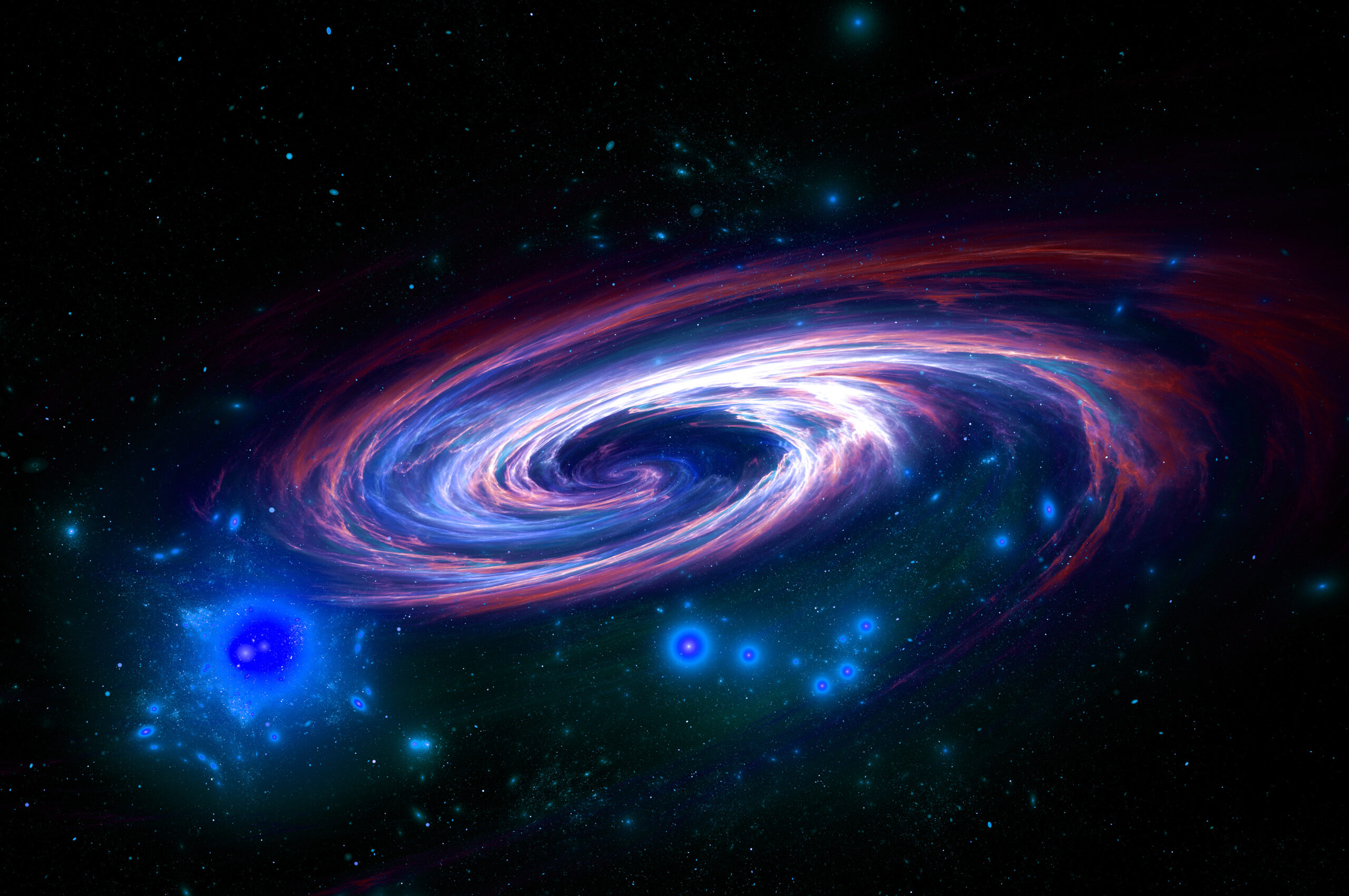All Quiet on the Galactic Front
Famous novel and movie All Quiet on the Western Front features German soldiers in World War I returning home for short leaves from the heat of battle on the Western Front. At the story’s end, the protagonist is killed on a remarkably peaceful day, a day in which the situation report states, “All quiet on the Western Front.”
Our Galaxy’s Recent Quiet Period
For many reasons, advanced life is possible only within a large spiral galaxy.1 However, all large spiral galaxies possess life-threatening supermassive black holes in their cores. (A supermassive black hole [SMBH] is a black hole with a mass exceeding one million times the Sun’s mass.) Our galaxy is no exception.
For nearly all our galaxy’s 13.5-billion-year history its SMBH has been generating radiation deadly for advanced life and crippling for advanced civilization. However, in its very recent history, coinciding with the appearance of the human race, it has been “all quiet on the galactic front.” Now, in a special issue of Astrophysical Journal Letters, a collaboration team of over 200 astronomers has published ten papers in which they produce the first-ever image of the event horizon of our galaxy’s SMBH and explain why it has been so exceptionally benign throughout the human era.
Event Horizon Images
The event horizon of a black hole is the distance from the black hole’s center where the gravitational force of the black hole is so strong that nothing, not even light, can escape its grip. To an outside observer, everything inside the event horizon will appear black.
The more massive a black hole, the more distant its event horizon will be from the black hole’s center. Nevertheless, even for the most massive black holes the diameter of the event horizon is relatively tiny. It is so small, in fact, that astronomers had to connect millimeter-wave telescopes all around the world as an interferometer to gain sufficient resolving power to image the event horizons of the two largest, as seen from Earth, black holes. Figure 1 shows the array of millimeter-wave telescopes that make up the radio interferometer known as the Event Horizon Telescope (EHT).
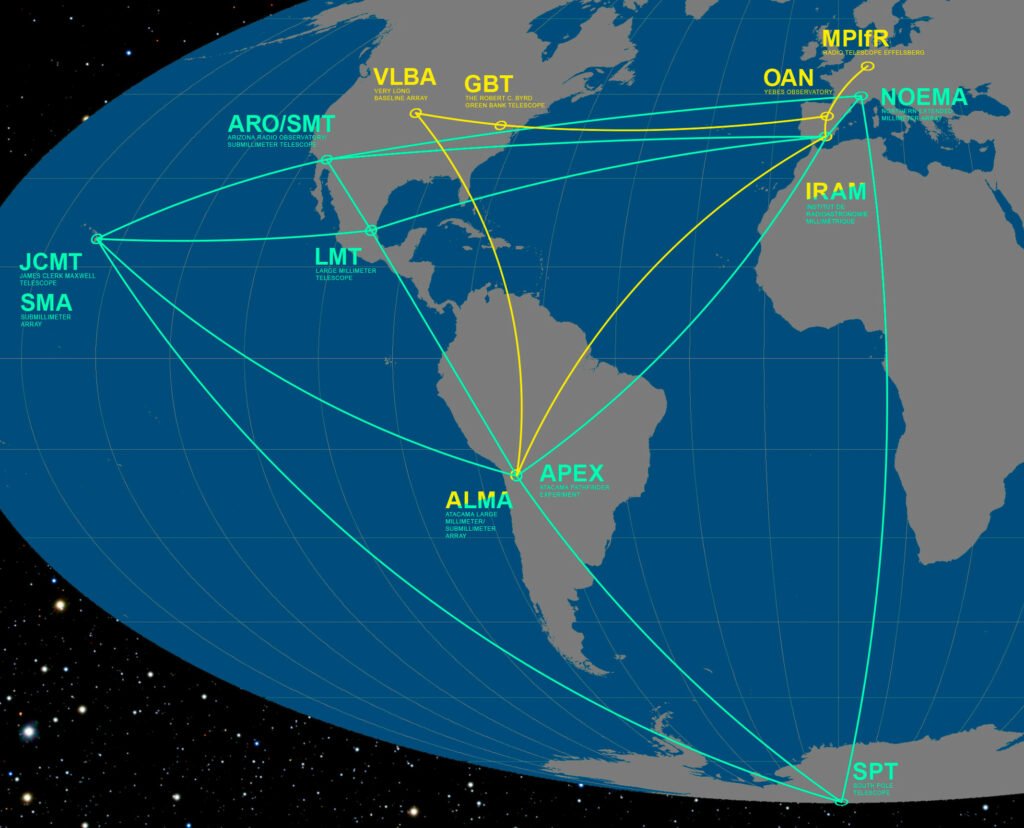
Credit: ESO/O. Furtak
The EHT has a resolving power of 0.000025 arc seconds, which is 4,000 times superior to the best resolving power of the James Webb Space Telescope. It has the capability of resolving the head of a match on the surface of the Moon. It is the only available instrument powerful enough to detect and measure the diameter of a black hole’s event horizon. It can only do so, though, for two known black holes: the SMBH (mass = 6.5 billion solar masses2) in the core of the giant galaxy M87 53.8 million light-years away,3 and the SMBH (mass = 4.152 ± 0.014 million solar masses4) in the Milky Way Galaxy’s (MWG) core 26,673 light-years away.5
The Event Horizon Telescope Collaboration (EHTC) imaged the event horizon of M87’s SMBH in 2019. Figure 2 shows the image. The bright donut of light just outside the event horizon is where incoming matter is being converted into energy with 10–40% efficiency. For comparison, the Sun’s nuclear furnace is converting matter into energy with 0.07% efficiency. Because M87’s SMBH is drawing in copious amounts of matter towards its event horizon, its event horizon is fairly well defined.
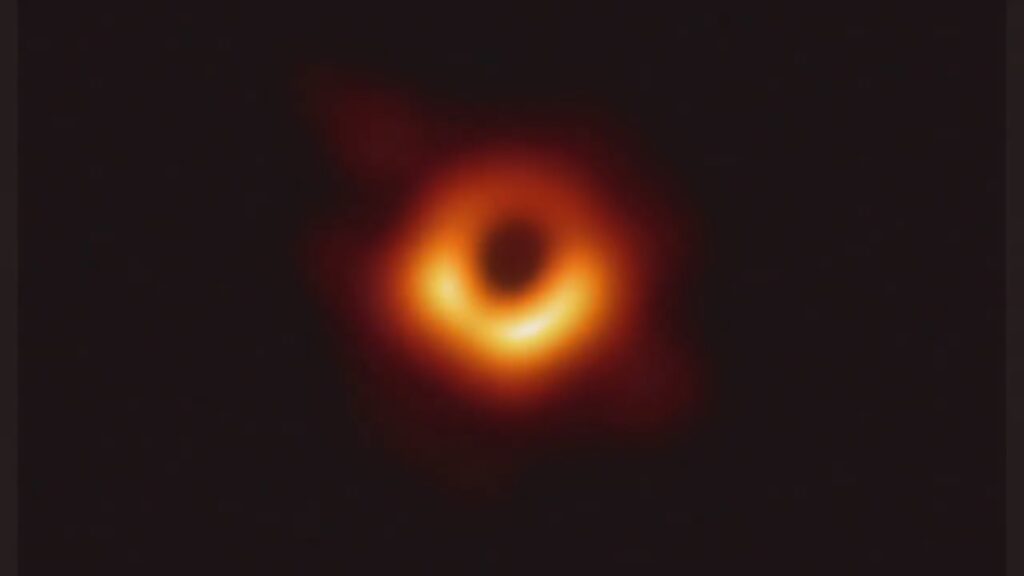
Credit: Event Horizon Telescope Collaboration
The SMBH in our galaxy’s core is drawing in much less matter than M87’s SMBH. Therefore, in spite of its relative proximity to Earth, it was much more challenging to image its event horizon. Not until May 2022 was the EHTC able to accumulate enough observational data to produce a preliminary image. Figure 3 shows its image.
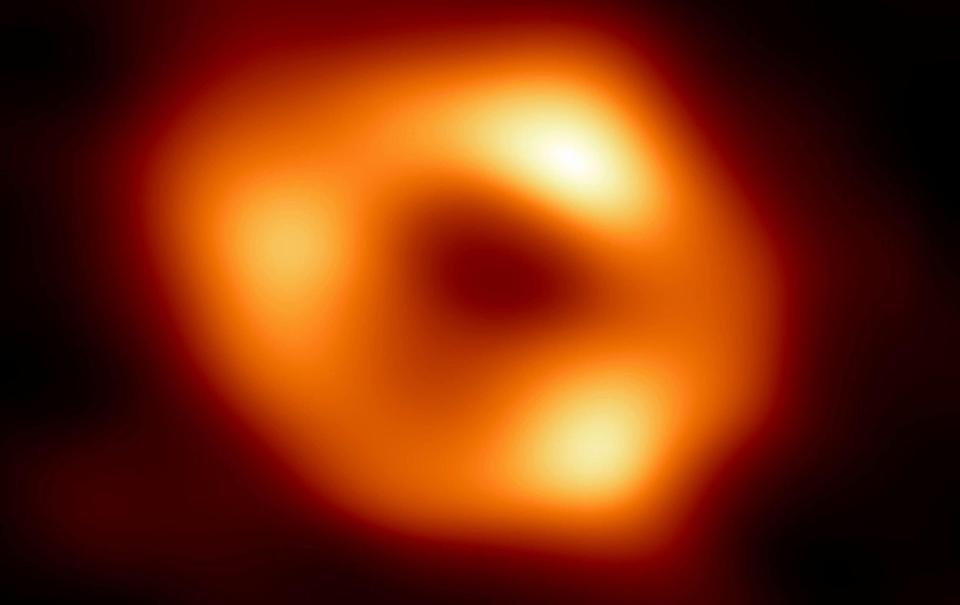
Credit: Event Horizon Telescope Collaboration
Our Galaxy’s Marvelous Supermassive Black Hole
Our galaxy’s SMBH is extraordinary in several respects. First, it possesses an exceptionally low mass. Extensive observations of other large spiral galaxies establish that the mass of a spiral galaxy’s SMBH is proportional to (1) the mass of the galaxy’s central bulge,6 (2) the number of globular clusters orbiting the galaxy,7 and (3) the velocity dispersion (range of velocities) of stars in the central bulge.8 By these measures, the mass of our galaxy’s SMBH should be at least 30 times greater.
The Andromeda Galaxy, which has the same total mass as our galaxy, possesses an SMBH that fits the above-stated correlations well. Its mass exceeds that of the MWG’s SMBH by a factor of 35 times. The much lower mass of our galaxy’s SMBH means that its gravity is much weaker and, therefore, less able to draw matter towards its event horizon.
In the fifth of the ten recent papers published by the EHTC, the 272 astronomers determined the rate at which the SMBH is accreting matter. The rate is 7.3 ± 2.1 x 10-9 solar masses per year.9 This rate translates into only one-fifth of the Moon’s mass per year.
In the third of the ten papers, 263 astronomers determined the variability of radiation from just outside the SMBH’s event horizon.10 Variability was seen on timescales as short as 1 minute but typical timescales were about 10 minutes. The degree of variation was only about 5%. These variability determinations mean that our galaxy’s SMBH is drawing matter toward its event horizon at a nearly continuous and constant rate. It is consuming—at a relatively constant rate—the equivalent of about twice the mass of Mars’s tiny moon Phobos (diameter = 14 miles or 22.5 kilometers) every ten minutes.
This 5% degree of variation of electromagnetic emission implies that, while the mass being drawn in toward our galaxy’s SMBH adds up to twice the mass of Phobos every 10 minutes, it is not composed of bodies anywhere near as large as Phobos (with rare exceptions). Rather, gas and dust must account for most of that mass, with just a small fraction being composed of asteroids and comets much smaller than Phobos.
This conclusion deduced from the EHTC’s multi-year observations of the donut of radiation outside our galaxy’s SMBH affirms an earlier inference based on observed flares emitted from the region containing our galaxy’s SMBH. That inference is that our galaxy’s SMBH must be surrounded by a dense cloud of small asteroids and comets.11 Collisions among the asteroids and comets would generate copious amounts of gas and dust. That gas and dust would explain the nearly steady and continual emission of radiation from the donut beyond our galaxy’s SMBH’s event horizon. The occasional infall of a tiny asteroid or comet toward the event horizon would explain the observed variation in the emission of radiation.
In the fifth of the ten papers, the authors calculated the bolometric luminosity (average total emission from all wavelengths) from the donut beyond our galaxy’s SMBH’s event horizon.12 The bolometric luminosity = 8.0 ± 1.2 x 1035 ergs per second, which is 200 times greater than the Sun’s bolometric luminosity.
Designed for Advanced Life
Even for an SMBH that weighs in at just 4.15 million solar masses, the emission and variability of radiation currently exhibited by our galaxy’s SMBH are extremely low. However, such remarkably low radiation is the exception, not the norm.
In another study, astronomers discovered two bubbles, each more than a quarter the diameter of our galaxy’s stellar disk (see figure 4). The bubbles are comprised of diffuse, uniform, low-level gamma rays13 and soft x-rays.14 A follow-up study revealed two chimneys of x-ray emission connecting the bubbles to our galaxy’s nucleus.15 This finding affirmed that our galaxy’s SMBH is responsible for the bubbles.
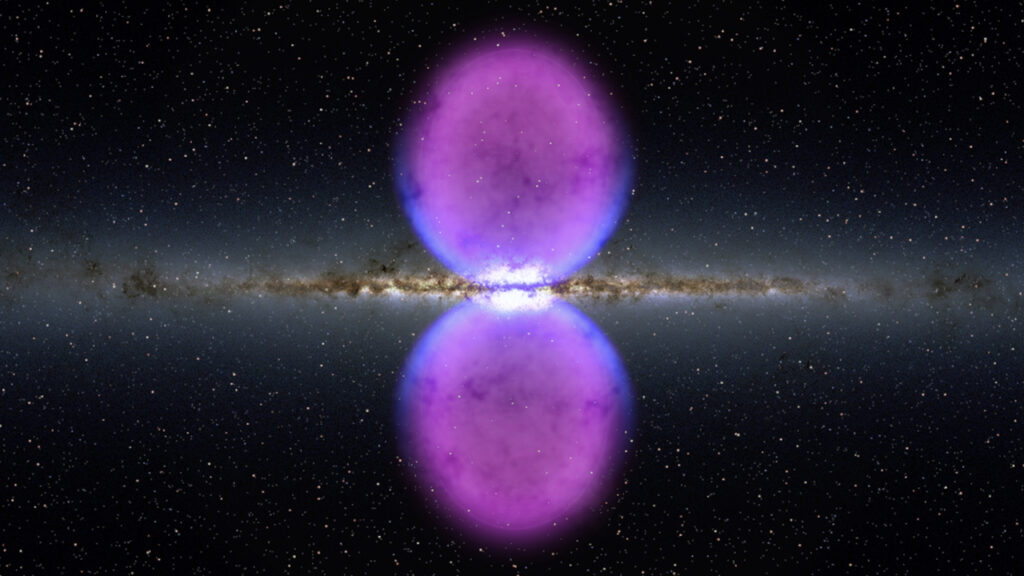
Credit: NASA Goddard Space Flight Center
The bubbles’ size and diffuse nature disclosed that the events that generated them occurred several million years ago. The fact that the radiation levels in the bubbles are so low indicates that any nonhuman life, though impacted by the events, would not have been driven to extinction.
For at least the past 12,000 years, the radiation activity level outside the event horizon of our galaxy’s SMBH has been exceptionally low. If it were not for our galaxy’s SMBH being so extremely quiet, humans would not have been able to launch civilization 12,000 years ago, nor would they have been able to sustain it throughout the past 12,000 years. Thanks in part to events being all quiet on the galactic front, humans today possess the civilization, wealth, and technology for billions of us to hear and respond to the Christian gospel message.
Endnotes
- Hugh Ross, The Creator and the Cosmos, 4th ed. (Covina, CA: RTB Press, 2018), 200–206; Hugh Ross, Designed to the Core (Covina, CA: RTB Press, 2022), chapter 7.
- Event Horizon Telescope Collaboration, “First M87 Event Horizon Telescope Results. VI. The Shadow and Mass of the Central Black Hole,” Astrophysical Journal Letters 875, no. 1 (April 10, 2019): id. L6, doi:10.3847/2041-8213/ab1141.
- Alexa Villaume et al., “The Assembly History of M87 through Radial Variations in Chemical Abundances of Its Field Star and Globular Cluster Populations,” Astrophysical Journal 900, no. 2 (September 10, 2020): id. 95, doi:10.3847/1538-4357/aba616.
- Gravity Collaboration, R. Abuter et al., “A Geometric Distance Measurement to the Galactic Center Black Hole with 0.3% Uncertainty,” Astronomy & Astrophysics Letters 625 (May 2019): id. L10, doi:10.1051/0004-6361/201935656.
- Gravity Collaboration, “A Geometric Distance Measurement.”
- Stefano de Nicola, Alessandro Marconi, and Giuseppe Longo, “The Fundamental Relation between Supermassive Black Holes and Their Host Galaxies,” Monthly Notices of the Royal Astronomical Society 490, no. 1 (November 2019): 600–612, doi:10.1093/mnras/stz2472; G. Yang et al., “Evident Black Hole-Bulge Coevolution in the Distant Universe,” Monthly Notices of the Royal Astronomical Society 485, no. 3 (May 2019): 3721–3737, doi:10.1093/mnras/stz611.
- Rosa A. González-Lópezlira et al., “The Relation between Globular Cluster Systems and Supermassive Black Holes in Spiral Galaxies: The Case Study of NGC 4258,” Astrophysical Journal 835, no. 2 (February 1, 2017): id. 184, doi:10.3847/1538-4357/835/2/184; Gretchen L. H. Harris, Gregory B. Poole, and William E. Harris, “Globular Clusters and Supermassive Black Holes in Galaxies: Further Analysis and a Larger Sample,” Monthly Notices of the Royal Astronomical Society 438, no. 3 (March 1, 2014): 2117–2130, doi:10.1093/mnras/stt2337.
- Christopher Marsden et al., “The Case for the Fundamental MBH-σ Relation,” Frontiers in Physics 8 (March 17, 2020): id. 61, doi:10.3389/fphy.2020.00061; Alper K. Ates, Can Battal Kilinç, and Cafer Ibanoglu, “On the M-σ Relationship and SMBH Mass Estimates of Selected Nearby Galaxies,” International Journal of Astronomy and Astrophysics 3, no. 3A (July 2013): 1–9, doi:10.4236/ijaa.2013.33A001.
- Kazunori Akiyama et al., “First Sagittarius A* Event Horizon Telescope Results. V. Testing Astrophysical Models of the Galactic Center Black Hole,” Astrophysical Journal Letters 930, no. 2 (May 10, 2022): id. L16, doi:10.3847/2041-8213/ac6672.
- Kazunori Akiyama et al., “First Sagittarius A* Event Horizon Telescope Results. III. Imaging of the Galactic Center Supermassive Black Hole,” Astrophysical Journal Letters 930, no. 2 (May 10, 2022): id. L14, doi:10.3847/2041-8213/ac6429.
- Kastytis Zubovas, Sergei Nayakshin, and Sera Markoff, “Sgr A* Flares: Tidal Disruption of Asteroids and Planets?” Monthly Notices of the Royal Astronomical Society 421, no. 2 (April 10, 2012): 1315–24, doi:10.1111/j.1365-2966.2011.20389.x; Sergei Nayakshin, Sergey Sazonov, and Rashid Sunyaev, “Are Supermassive Black Holes Shrouded by ‘Super-Oort’ Clouds of Comets and Asteroids?,” Monthly Notices of the Royal Astronomical Society 419, no. 2 (January 11, 2012): 1238–1247, doi:10.1111/j.1365-2966.2011.19777.x.
- Akiyama et al., “First Sagittarius A* Event Horizon Telescope Results. V. …
- Meng Su, Tracy R. Slatyer, and Douglas P. Finkbeiner, “Giant Gamma-Ray Bubbles from Fermi-LAT: Active Galactic Nucleus Activity or Bipolar Galactic Wind?,” Astrophysical Journal 724, no. 2 (November 10, 2010): 1044–1082, doi:10.1088/0004-637X/724/2/104.
- P. Predehl et al., “Detection of Large-Scale X-Ray Bubbles in the Milky Way Halo,” Nature 588, no. 7837 (December 10, 2020): 227–231, doi:10.1038/241586-020-2979-0.
- G. Ponti et al., “An X-Ray Chimney Extending Hundreds of Parsecs above and below the Galactic Centre,” Nature 567, no. 7748 (March 21, 2019): 347–350, doi:10.1038/s41586-019-1009-6.


